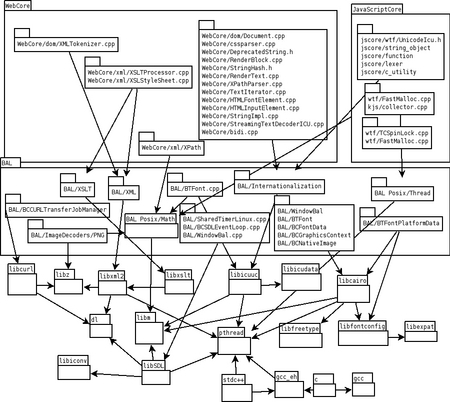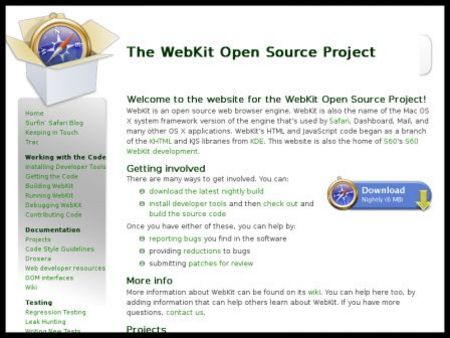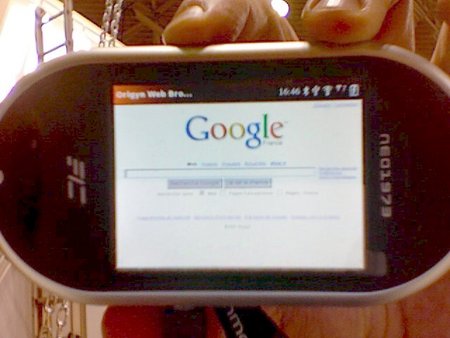Introducing OWB, an open-source browser for consumer devices
Aug 1, 2007 — by LinuxDevices Staff — from the LinuxDevices Archive — 16 views Foreword: This article by Jean-Charles Verdie, CTO of software development firm Pleyo, introduces the Origyn Web Browser, a new open-source browser that targets a wide range of consumer electronics (CE) devices, including mobile phones, PMPs (portable media players), and STBs (set-top boxes).
Foreword: This article by Jean-Charles Verdie, CTO of software development firm Pleyo, introduces the Origyn Web Browser, a new open-source browser that targets a wide range of consumer electronics (CE) devices, including mobile phones, PMPs (portable media players), and STBs (set-top boxes).
by Jean-Charles Verdie
Introduction
digg this story |
The Origyn Web Browser (OWB), created by Pleyo, was designed for use in a wide range of consumer electronics (CE) devices, such as mobile phones, portable media players, GPS devices, PVRs and other set-top boxes, home-gateways, Web-radios, and so on.
OWB makes use of the latest Web standards. It provides access to external Web services, enabling the implementation of functions such as user interface administration and animation.
Pleyo recently released OWB on an open source basis at Sand-Labs.org, under a BSD License.
Architecture
OWB is based on Apple's WebKit open-source Web browser engine, which has set a worldwide standard for Web browsing. To the standard WebKit architecture, Pleyo has added an abstraction layer, known as the “OWB Abstraction Layer” (OwBal).
The OwBal architecture dramatically eases the task of integrating OWB in CE devices, resulting in fast and easy implementation on targeted platforms. The aim of this abstraction layer is to allow CE software manufacturers to leverage existing libraries, instead of having to port the browser along with its full set of dependencies.
To ease the task of porting OWB to new platforms and devices, Pleyo published the OwBal Porting Guide. This guide, which is expected to evolve rapidly, provides a high-level overview of how to deal with OwBal, along with common “trick and tips” of embedded system ports. The Porting Guide is published under Creative Commons License Attribution 2.0 France, and can therefore be reworked by anyone, given that Pleyo remains cited as original author.
The OwBal architecture, while looking complicated, is actually very straightforward; additionally, the CCMake architecture makes it easy to select which components need to be ported or not.
Here's a comprehensive diagram of the abstraction layer:

OwBal architecture diagram
(Click to enlarge)
The suggested development setup is a chrooted Gentoo-based environment, which comes with a straightforward installer. Note that OWB natively comes with a gentoo ebuild file, allowing the developer to do a simple “emerge owb” to get the up-to-date official build, and “emerge owb-svn” to start working on the tree version.
A CCMake compilation environment allows easy reconfiguration. The screenshot below illustrates the control of the Font Engine:

Font Engine reconfiguration using CCMake
(Click to enlarge)
Current ports
Pleyo has already ported OWB to various platforms for consumer device manufacturers, but the company has also released open implementations, such as an SDL (Simple DirectMedia Layer) implementation (the core one), and also a port for the Nokia N800 Internet tablet.
The N800 port currently comes as a patch along with specific documentation, but Pleyo has announced that the next OWB release will include N800 as a mainstream option, just asOS X and Linux/SDL are today.
Here are a few screenshots showing OWB in action:

OWB running on Linux/SDL
(Click to enlarge)

OWB running on OS X
(Click to enlarge)

OWB running on the Nokia N800 Internet Tablet!
(Click to enlarge)

OWB running on the FIC Neo1973 open touchscreen phone
(Click to enlarge)
Future plans, how to get involved
Currently, OWB is being continuously tested and updated by a growing community of both developers and companies. Thus, it is constantly evolving to keep up with the latest Web technologies.
The strategy is to release two versions per year, which are intended to include significant evolutions, such as integrating an optimized SVG renderer, and extracting the XML parser from the core browser. Everyone is welcome to come and grab tickets from the OWB website.
Companies are invited to contact Sand-Labs's board, to get further information on how to become involved in various ways in the open source project.
Because OWB is released under a BSD License, it easily merges with both open and proprietary projects.
Further information is available from:
About the author: Jean-Charles Verdie is CTO at Pleyo, which describes itself as a “web-enabler for consumer electronic devices and a software editor specialized in Web technology for mobile phones, PMPs, STBs, wireless devices, etc.” The company, which is focused on “a range of bundled solutions for CEM and Operators in order to deliver contents and services on CE devices,” is located in Montpellier, France.
This article was originally published on LinuxDevices.com and has been donated to the open source community by QuinStreet Inc. Please visit LinuxToday.com for up-to-date news and articles about Linux and open source.